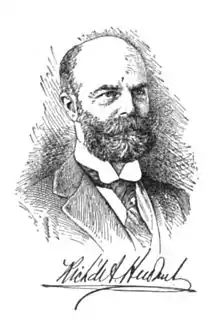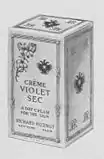Richard Hudnut
Richard Alexander Hudnut (June 2, 1855 – October 30, 1928)[1] was an American businessman recognized as the first American to achieve international success in cosmetics manufacturing.[2] The company once maintained separate US and European headquarters on Fifth Avenue in New York City and on the Rue de la Paix in Paris, respectively.
Richard Hudnut | |
|---|---|
 | |
| Born | June 2, 1855 |
| Died | October 30, 1928 (aged 73) Juan-les-Pins, France |
| Occupation | Cosmetologist, perfumer, pharmacist |
| Known for | Cosmetics and perfumes |
| Spouse(s) | Evelyn Isabell Beals Winifred Kimball |
Although his fortune had been built around cosmetics and beauty products, he preferred to be known as a "perfumer".
Family
Hudnut's father Alexander (1830–1900) was a pharmacist with a store at Broadway and Ann Street in New York City. His mother was Margaret (née Parker).[3] The name Hudnut derives from Hodnet, Shropshire.[3] After graduating from Princeton University, Richard Hudnut toured France and returned with the idea of introducing French-style perfumes and cosmetics to American women. In 1880 he registered his name as a trademark in both France and the United States.[2]

Hudnut began by transforming the family drugstore into an elegant showroom.[2] The makeover was such that the shop now became a tourist attraction, and Hudnut's business flourished. In time, Hudnut's products became so widely known that he closed the retail store and focused on marketing his product lines through wholesale distributors.[4][5]
One of the keys to Hudnut's success was that he sold his less expensive fragrances "on approval". After the consumer paid with postage stamps or a money order, Hudnut shipped the perfume. If the customer wasn't satisfied, Hudnut refunded his money.
Having made his fortune, Hudnut sold the business in 1916 and retired to France.
The Richard Hudnut Corporation was acquired in 1916 by William R. Warner & Company, which became Warner-Lambert in 1955. In 2000, Warner-Lambert was purchased by Pfizer Corporation, now the world's largest pharmaceutical corporation.
Perfumes and Cosmetics
Early Richard Hudnut fragrances included Queen Anne Cologne (1880), Violet Sec (1896), Aimée (1902), DuBarry (1903), Vanity (1910), and Three Flowers (1915).[6]
Product lines include Du Barry, Three Flowers, Gemey, Marvelous and a highly successful line of hair care products.[7] Hudnut's beauty products were sold in department stores, an indication of their appeal to a more affluent and sophisticated clientele. The firm also introduced the Du Barry Success Course which ran from 1940 until the early 1950s[8] which Mary Brooks Picken helped design.
To maintain his image, Hudnut required dealers to sign a contract stating that not only would they not discount his products, they would not bundle his products with gifts of any kind (so as to, in effect, lower their purchase price.) Although this policy was outlawed in certain states (i.e., Texas), in states where it was enforceable, the company enforced it to the extent of the law.[9][10] In 1922 however, the government charged Richard Hudnut Inc. with conspiracy to violate the Sherman Antitrust Act as a result of its price-control activities.[11] Richard Hudnut, Inc. and Richard Hudnut Sales Company, a subsidiary, were again charged with unfair trade-practices in 1936, under the Robinson-Patman Act.[12]
Incidents
A number of colorful incidents marked Richard Hudnut's life.
In 1894, Richard Hudnut filed suit against the department store Carroll, Beadle & Mudge of Rochester, New York for allegedly selling pirate Hudnut perfume as the real thing.[13]
In 1901, the U.S. Customs Service sent an officer to his house to inquire about certain imports that Hudnut was receiving at a particularly low cost, as no duty was being paid. The officer was told that Hudnut was not at home.[14]
In 1901, a patent solicitor named Oscar Michel was arrested on $5000 bail for passing a bogus cheque to Richard Hudnut. Hudnut had had the solicitor file a patent application for him but when he didn't receive it from the patent office, he demanded his money back from Michel. The cheque was returned "N.G." (non-negotiable).[15]
In 1902, Richard Hudnut was exonerated on smuggling charges alleged to have been conducted by a steamship steward. The steward was arrested for smuggling violet essence and musk into the United States, some of which was traced to Hudnut's pharmacy. On further investigation, the collector entirely cleared Hudnut of any wrongdoing.[16]
In March 1903, Richard Hudnut bought a suite of Louis Quinze chairs for $220 at an auction of actress Ada Rehan's personal property.[17]
In 1905, returning from a summer vacation at his Adirondacks camp, Hudnut discovered that his New York apartment had been looted; even his grand piano was gone.[18]
In 1909, Hudnut applied for a tax refund on alcohol which had been used in cosmetics which were to be exported. The Collector of Customs granted the request but demanded precise accounting of the quantities used in manufacturing, including any waste.[19]
In 1915, Swift & Company sued Richard Hudnut for trademark infringement. Swift had registered the trademark "Vanity Fair" and challenged Hudnut's right to use the name "Vanity". The court ruled in favor of the plaintiff, in spite of the fact that Hudnut had registered his trademark earlier than Swift, on the grounds that Hudnut had used the name "Vanity", only once, and that use had not been public; it had been used on an invoice only.[20]
In 1920, in another trade-mark dispute over the name "Nara" which Hudnut had registered and which was disputed by plaintiff Phillips who had registered the trade-mark "Nyra", Hudnut prevailed on appeal on the same legal principle that had found against him in Swift v. Hudnut.[21][Note 1]
In 1922, after he had retired from business, Hudnut's stepdaughter, Natacha Rambova, married Rudolph Valentino,[22] who, as it turned out, had not completed his divorce from his first wife.[23]
Other interests
Richard Hudnut was also the president of the Hudnut Realty Co.[24]
Marriages

Richard Hudnut was married twice. His first wife Evelyn Isabell Beals (d. 1919),[25] whom he married on May 14, 1881, was the daughter of granite dealer Horace Beals,[3] and Jane A. Dwyer, better known as the Duchess of Catelluccia.[26]
His second wife, Winifred Kimball Hudnut (1871 – 1957), was the mother of Natacha Rambova (née Winifred Shaugnessy).[1] Hudnut was her fourth husband.[27]
Community service
Hudnut was a member of several professional organizations including the American Pharmaceutical Association, the Manufacturing Perfumers' Association of the United States of which he had been variously, chairman, vice-president and treasurer,[28] the American Geographical Society, the Metropolitan Museum and the Republican Club of New York.[3]
Death

Richard Hudnut died in 1928,[29] at the age of 73,[30] at Juan-les-Pins, France, where he owned a château.[31] He is buried in Woodlawn Cemetery in The Bronx, New York City.
Hudnut in popular culture
By the time that they had reached Twenty-third Street, the dreamer had come back to earth sufficientiy to feel that a glass of soda water would taste good. She intimated as much to her cavalier.
They walked over to Hudnut's. Calleen ordered raspberry flavor, and Stanley called for vanilla.
"Put plenty of ice cream into mine!" Calleen admonished the clerk.[32]
Richard Hudnut products (1915)
 Skin cream
Skin cream DuBarry face powder
DuBarry face powder Milk of Cucumbers and Orris
Milk of Cucumbers and Orris Orchid Beauty Cream
Orchid Beauty Cream "Soul of the Violet" perfume
"Soul of the Violet" perfume "Tout mon jardin" pot-pourri
"Tout mon jardin" pot-pourri "Violet sec" toilet water
"Violet sec" toilet water
Notes
- "The common law, and not the trade-mark statutes, defines what constitutes a trade-mark. The trade-mark recognized by the common law is generally the outgrowth of a considerable period of use rather than a sudden invention. The exclusive right to it grows out of its use and not its mere adoption. (Trade Mark Cases, i00 U.S. 82, 84) The trader must apply the mark to a vendible commodity and must actually put the commodity so marked on the market. Phillips v. Hudnut et al. (1920) 273 O.G. 629, Court of Appeals of the District of Columbia
References
- "Did Valentino speak from the grave?" (May 26th, 2010) Hollywoodland: A site about Hollywood and its history
- Geoffrey Jones (2010) Beauty Imagined: A History of the Global Beauty Industry, Oxford University Press ISBN 978-0199639625
- The National Cyclopaedia of American Biography (1910) James T. White and Company, New York
- American Druggist and Pharmaceutical Record, Vol. 62 (1914)
- "Hudnut Sells Out" (December 31, 1889) New York Times
- "Hudnut, Richard" Perfume Intelligence - The Encyclopaedia of Perfume
- "Richard Hudnut". Cosmetics and skin. Retrieved 22 December 2016.
- "Du Barry Success Course". Cosmetics and Skin. Retrieved 22 December 2016.
- "Richard Hudnut: Policy to be Maintained" (Sep. 1916) The National Druggist, Vol.46 p.390
- Galloway et al. (1911) "Advertising, Selling and Credits", Modern Business Vol.9, Alexander Hamilton Institute, New York
- "Government Charges Conspiracy to Violate Sherman Anti-Trust Law" (November 9, 1922) The New York Times
- "Unfair Trade Charges Filed: Several Companies Named in Complaints" (Nov 9, 1936) Los Angeles Times
- The Merck Report Vol.3 (1894) Merck & Company, New York
- "THE CUSTOMS COURT.; Government Contests Decision on Perfume Bottles--Files Other Appeals" (January 29, 1929) The New York Times
- "Charged with Issuing a Bogus Check" (March 12, 1901) New York Times
- "Richard Hudnut Exonerated" (January 5, 1902) The New York Times
- "Ada Rehan Collection Sale" (March 7, 1903) The New York Times
- "ANOTHER RICH HOME STRANGELY ROBBED; Thieves Must Have Had Divining Rods or Inside Knowledge. RICHARD HUDNUT THE VICTIM Jewels Vanish Though Hidden -- Fifth Avenue Residences Robbed to the Extent of $1,000,000." (November 26, 1905) The New York Times
- Treasury Decisions (1910)
- Trade Mark Reporter, Volume 5 (1915)
- The Federal Reporter: Cases Argued and Determined in the Circuit and District Courts of the United States, Volumes 263-264 (1920) West Publishing Company
- "MISS HUDNUT WILL WED A MOVIE STAR" (May 10, 1922) The New York Times
- "MAY CITE MANN ACT AGAINST VALENTINO; Federal Officials Start Inquiry Into Screen Actor's Nuptials With Miss Hudnut." (May 19, 1922) The New York Times
- Directory of Directors in the City of New York (1915)
- "Mrs. Evelyn Isabell Hudnut" (September 14, 1919) The New York Times
- Duchess of Castelluccia's Will" (August 7, 1895) The New York Times
- Natacha Rambova, Hala Pickford (2010) Rudolph Valentino: A Wife's Memories of an Icon, PVG Publishing ISBN 978-0981644042
- Annual Meeting of the Manufacturing Perfumers' Association of the United States, Volume 9 (1903)
- "END COMES TO HUDNUT IN FRANCE: Millionaire Perfume Man, Victim of Heart Disease, Dies at Resort Villa" (31 Oct 1928) Los Angeles Times
- "RICHARD HUDNUT DIES ON RIVIERA; Perfume Manufacturer Was at His Villa at Juan Les Pins, Resort Near Nice. HAD FAMOUS HOME HERE; The Castle, at Greenwich, Was Often Pictured in Movies—Stepfather of Mrs. Rudolph Valentino." (Oct. 31, 1928) The New York Times
- "Americans Buy Up Ruined Castles of Old France" ( Dec 14, 1924) Los Angeles Times
- Caroline C. Walch (1898) Doctor Sphinx, F. Tennyson Neely, New York
External links
- Photograph of Richard Hudnut with his wife Winifred, his step-daughter Winifred Shaughnessy (Natacha Rambova) and his son-in-law Rudolph Valentino.
- Link to online copy of Beauty Book by Richard Hudnut at Harvard University Library